Minimally Invasive Heart Surgery and Percutaneous Transluminal Coronary Angioplasty for Coronary Artery Disease
Minimally Invasive Surgery is a kind of surgery that allows surgeons to perform operations without causing huge wounds to patients, mainly through endoscopes and various imaging techniques.
Minimally Invasive Heart Surgery not only can reduce wound infection, reduce bleeding, and reduce pain, and it can reduce the damage of surrounding tissues, and the prognosis of patients is good.
Coronary heart catheter stent is a stent placed in the coronary artery, can provide blood to the heart, the purpose of the stent is to keep the artery open. For severely calcified blood vessels, through the coronary artery high-speed drill bit grinding technique, using a diamond grinding head at a high speed of about 150,000 to 180,000 revolutions per minute, rub away the hardest part of the blood vessel wall, at the same time avoid soft blood vessel walls. When the blood vessel is hardened and blocked by the lesion, then use a balloon to prop it up into the stent, the success rate of treatment is more than 95%.

Our Services
- Spinal Cord Injury cell therapy
- Intracranial neoplasm
- Bone Marrow Stem Cell Transplantation and Immune Cell and Oncolytic Virus Therapy for Serious Cancer
- Minimally Invasive Heart Surgery and Percutaneous Transluminal Coronary Angioplasty for Coronary Artery Disease
- Comprehensive Integrated Traditional Chinese Medicine and Western Medicine Therapy
- Minimally Invasive Gynecological Surgery and Reproductive Medicine
- Orthopedics and Soft Tissues and Regenerative Medicine
- Difficult Urinary diseases
- Breast Cancer Medicine
- Heavy Ion Radiotherapy for Cancer
